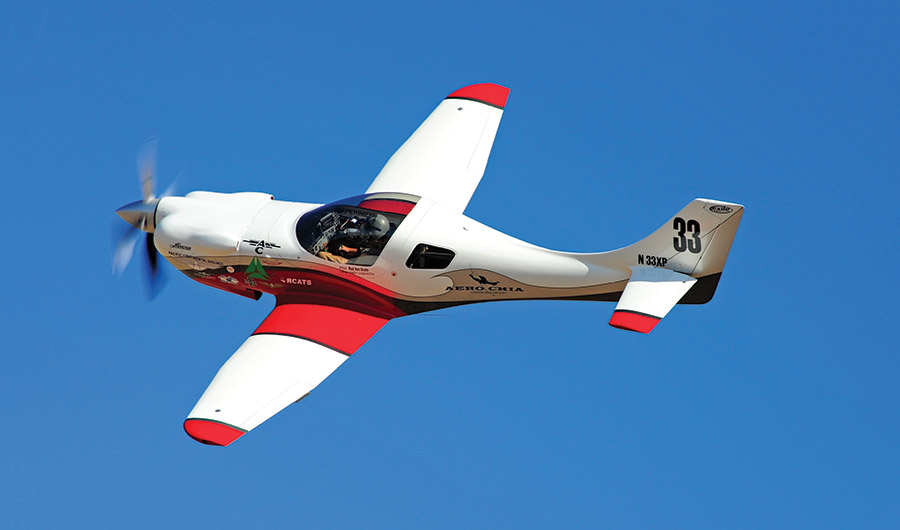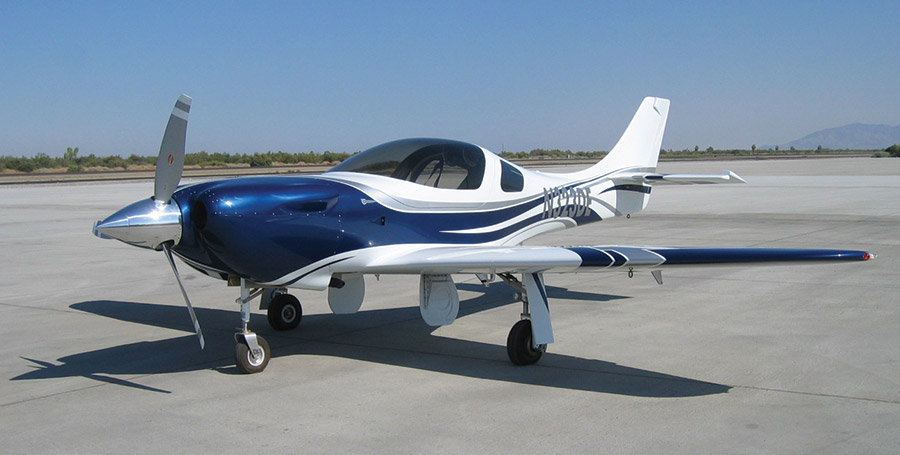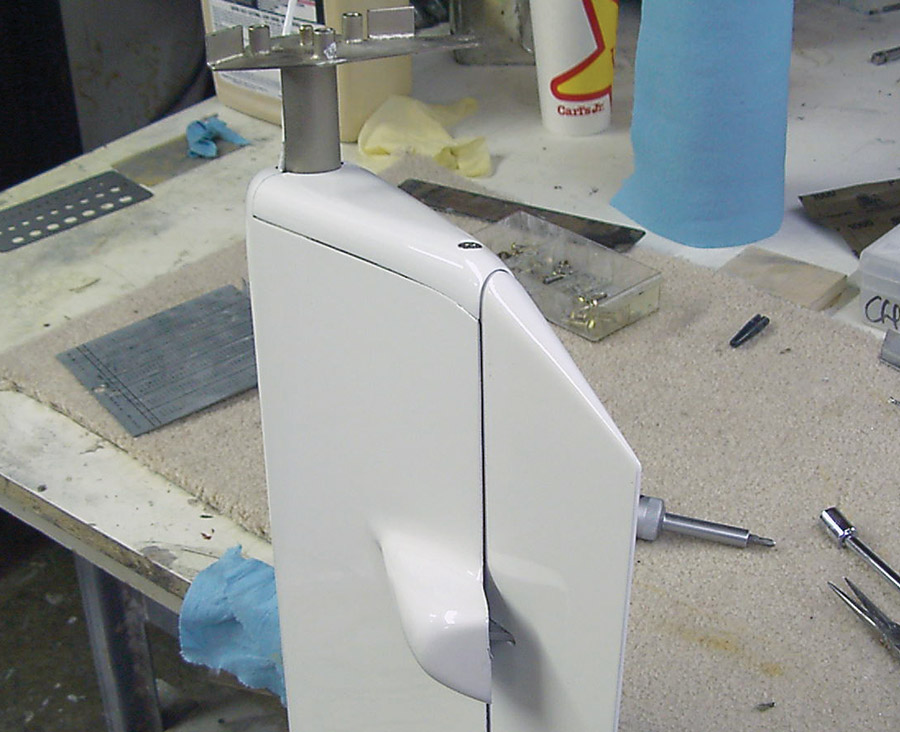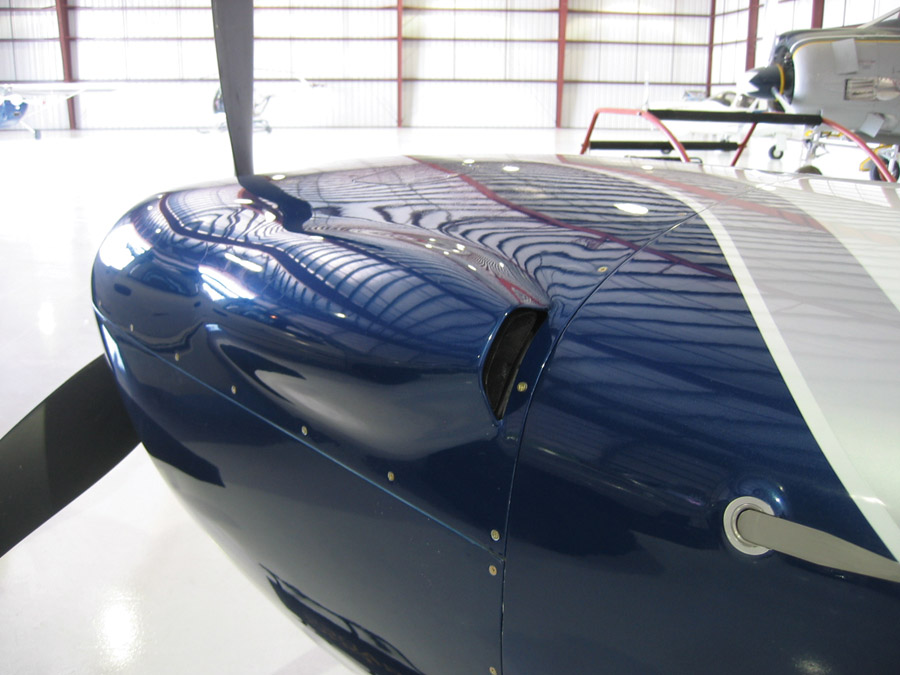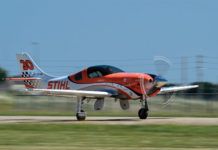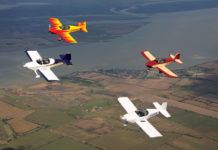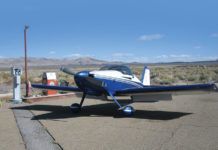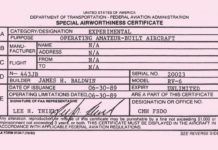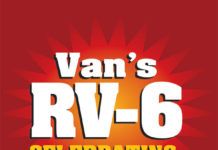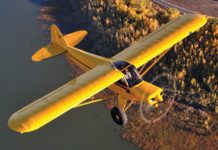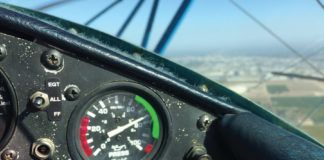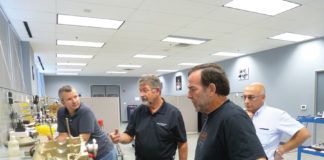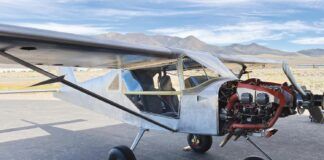Although the overhead roar of the Unlimited Class warbirds is admittedly the biggest draw of the annual National Air Races in Reno, Nevada, the Sport Class can make claims to being racing’s future: With 37 aircraft registered to race in 2015, the sport class has almost twice as many participants as any other class, and by far the greatest variety of aircraft types. Inaugurated in 1998, Sport Class rules are simple: any Experimental with an internal combustion engine(s) of less than 1000 cubic inches, and capable of 200 mph, can race. This means that, on the low end, most RVs with no or minimal mods can participate, while on the high end, highly modified ships have exceeded 400 mph on the course. A Lancair IV, piloted by Dave Morss, won the first race, and since then Lancairs have claimed numerous victories. KITPLANES sat down with one of the top composites fabricators in Experimental aviation, Andy Chiavetta, to talk about what’s involved in prepping a plane to race in Sport Class Gold.
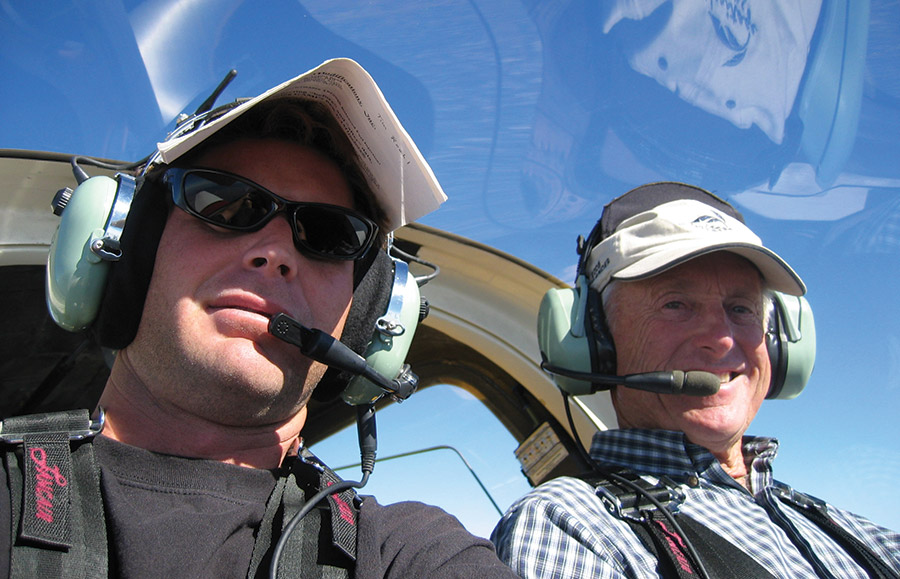
Andy Chiavetta (left) and Darryl Greenamyer on a ferry flight. Chiavetta credits Greenamyer with bringing him into the air racing world.
KITPLANES: Before we look at the specific mods you specialize in, generally speaking, what kind of aircraft are people who want to race building?
Andy Chiavetta: If you really want to win, you are most likely going to be dealing with a composite airplane, just because of the stiffness and strength inherent in these aircraft. Most of these airplanes are aerobatic category airplanes [i.e., +6/-3 G] because you are going to be pushing this plane way beyond what it was designed to do.
KP: Is there any engineering work being done on these airplanes? They are starting to go over 400 mph, and I wonder if they’ve been engineered for that.
AC: I can only speak for what I work on. We went to Lancair and spoke with the chief engineer/designer of the Legacy, Greg Cole, and told him what we wanted to do and were able to run some basic numbers. One thing about composite airplanes is that they tend to be conservatively designed to ensure the average guy’s safety. So a lot of times we are working on that extra strength for racing. Flutter is also a major concern. One good thing about carbon being so stiff is that it is naturally a better material for high speed.
KP: How was the Lancair flutter tested? In flight?
AC: No, they actually had a German company come shake test the airplane. But they only took it to the book VNE of the Lancair, not anywhere near what we were doing. But you could see some nodes that could have been a concern. To be on the safe side, we added two more layers of carbon to the aft fuselage skin; not so much to strengthen the tail as to stiffen it. Of course, to properly study that would be way out of the realm of what most people could afford. It was quite expensive to have the analysis done.
KP: You’ve worked on some NXTs. Any comments?
AC: Fast airplane. Flying characteristics are not exactly desirable (kind of like a modern Gee Bee), but you cannot deny speed. They are a difficult airplane to build and not well supported since there are just not that many of them.
One of the things we wanted to do was to start with a stable platform: a plane that is overbuilt, flies nicely, and doesn’t have nasty characteristics—because anything we do to it is going to exacerbate preexisting problems. The Legacy is a very nice flying airplane. I talked to Kevin Eldredge at Sun ‘n Fun 2016, and he had never flown one before. He flew one there and said, “You know, you told me it was a nice flying airplane, Darryl Greenamyer told me it was nice flying airplane, but until I flew it, I didn’t realize—this is a Cadillac.”

Chiavetta has assisted with two NXT builds. This one sports a completely new set of tail feathers for improved stability, as well as a new cowl to house Aerochia’s TSIO-550 package.
I’m not trying to sell Lancairs, but it was a good start for us. There are definitely other airplanes that fly well. As I said, it really depends on what you want to do. If you want to be the fastest RV, then that is fun, too.
That is airframes. On the engine side, if you want to go to the max, you need turbos or superchargers. Sport Class is limited to 1000 cubic inches, and there is not an engine that is normally aspirated that can make the horsepower in that power-to-weight ratio. I prefer turbos, though they have their own problems. They are heavier, they are a larger package. There is the complexity of an ADI system as well [ADI is anti-detonation injection, a fluid added to the intake charge to prevent detonation].
One of the things Darryl laughed about was, “My Bearcat was just as complex, but we had room.” The Legacy has the same amount of systems, but in a tiny package. Trying to package all that in there is really difficult. The Legacy being a two seater, you wouldn’t think the frontal would be great, but we use that area of the extra seat for the ADI tank. If you look at the frontal area of the Legacy, it appears to be less than the NXT. So it is about the smallest package you can get using a TSIO-550.
KP: What are the specific airframe mods you make to a Legacy for racing?
AC: Starting from the tail, we make all the gaps and seals as tight as possible. Also, the elevator edge is usually just squared off. On Lee Behel’s I made a molded shape on the inside so when the air goes around the horizontal, it had a surface to attach to and draw it away, since we saw some disturbances there.
Moving forward, we did a horizontal stab cuff where the HS leading edge meets the fuselage. We saw in tuft testing that, right where the horizontal met the fuselage, the air had a draggy stagnation point. So like a P-51 fin strake, but scaled down, we did a pointy strake to blend that in and that helped reattach the air.
Moving forward again, we did the tail wrap, which we talked about earlier. Initially we didn’t do that, but as the speeds increased we felt it was necessary.
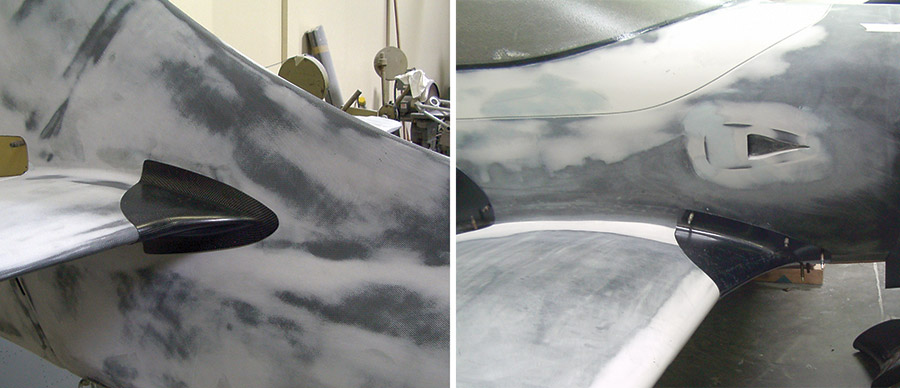
Leading edge mods on the horizontal stab (left) and wing (right) improve flow at the stagnation point.
KP: What clued you in that might be necessary?
AC: Just talking with Greg Cole. Every year we were going faster and faster, and we kept asking him, “What problems may we run into? Here is our data, here are the speeds we are doing, this is what the airframe is doing.” Greg would always be a few steps ahead of us with the engineering.
KP: Were you starting to see anomalous flying characteristics?
AC: We never saw any strange flying characteristics. It was more like, for example, at one of the races we saw 7 Gs at a certain speed. We asked ourselves, “Is flutter knocking on the door? How much is this spar going to take?” We had a lot of data from the Chelton that we could evaluate with the engineers.
I’ll get back to the fuselage mods in a moment, but on the turbo planes we actually shortened the engine mount. One of the things we did not want to change was the characteristics of the Legacy and how it flew. If we left the nose long, that would (1) create a nose-heavy condition because of the extra weight of the turbos, and (2) be destabilizing. So we shortened the nose to maintain stability.
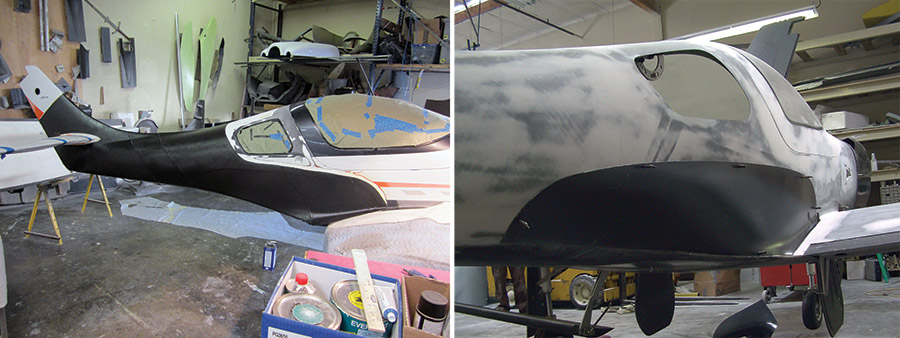
The tail wrap is a necessity for racing Lancairs (left). The side panel mod improves fuselage airflow aft of the thickest part of the wing (right).
KP: From the outside, does the cowl look like a stock Legacy?
AC: No. From the cowling line forward, mine are completely different, and they’re about an inch and a half shorter than a stock Legacy. The reason I mention all this is because looking at tail-forward mods, we also moved the battery location deep into the tail cone to counteract the weight. Initially we had a small counterweight in the tail as well, but after we did the tail wrap that little bit of extra weight over the whole surface that far back allowed us to get rid of the counterweight. Now we have the battery in the back of the tail cone, as well as the hydraulic system and any avionics stuff that had some weight if it is remote.
Moving forward, we did long-range fuel tanks for long-range racing. But we never really did use that, although we have used them for ferrying the airplane. In the cockpit itself, we changed the stick on Darryl’s airplane. It wasn’t totally necessary for racing, but he was complaining that under G-load he tended to hang on to the stick and PIO’d a little bit, so we moved the stick to a center stick with his arm resting on a console. It is more of a wrist action because the Legacy takes really fine movements—you don’t need a lot of input to fly it.
I had to completely redesign the control mechanism. Darryl actually brought me some Huey parts for the stick assembly which just happened to work pretty well because of the way the roller bearing worked.
After the first few years we were getting pictures of the airplane, and I could see under G-load the canopy line in front of the canopy was increasing from a gap of about 0.1 inch to close to 0.5 inch. The canopy doesn’t move—it’s pretty much its own entity. What was happening was the wing pushing up creating G-load, the tail creating download, and the engine mass pushing down with G-load. So the cockpit was flexing and elongating.
KP: That sounds scary.
AC: Terrifying. There are longerons on the side of the fuselage, so I added more unidirectional carbon there to stiffen that out. That helped; in later pictures you don’t see the gap. Another reason it didn’t become as much of a problem is when we first started doing Sport Class, we were on the small course; then they finally put us on the big course and the G-loads came down.
KP: Out of curiosity, what kind of G’s were you seeing on the old course versus the new?
AC: At times you would see excursions to 6 G’s. If you are flying the course right, you are not putting that many G’s on the plane; you should be at 2.5-3 G’s. But sometimes you get a bump or you have to pull hard because you’ve made a mistake and you see some G’s.
KP: You also modify the fuselage at the wingroot, correct?
AC: When we tuft tested Lee’s airplane, we noticed a disturbed area behind the trailing edge of the wing, mainly because the fuselage curved in and then back out. So we straightened that out with a side panel I made. That also ties into the wing leading edge where it meets the fuselage, just like the horizontal. So when we tufted and cleaned that up, it worked a lot better. Lee then took it even farther with the “Beluga” mod.
KP: What is the Beluga mod?
AC: The Beluga mod delays fuselage contraction aft of the thickest part of the wing for as long as possible. Basically Lee drew a line from that point straight back, eventually blending it back into the fuselage. That adds a lot to the fuselage width. It was a different philosophy than mine, but Lee’s plane was going faster—I’m not sure why. Lee was always very secretive; it could be that his speed was more from horsepower than drag reduction from the mod. But you can’t deny that Lee was fast.
Returning to the cockpit again, the Legacy lends itself to putting ADI in the passenger seat, which worked out really nice. At first we didn’t think we needed anything near that much volume, but as we get faster and are adding more power, we are using every bit of that tank.
KP: Can you say how many gallons an hour of ADI you are pumping?
AC: A lot. It took 15 years to get all that working, so I’m not going to divulge that!
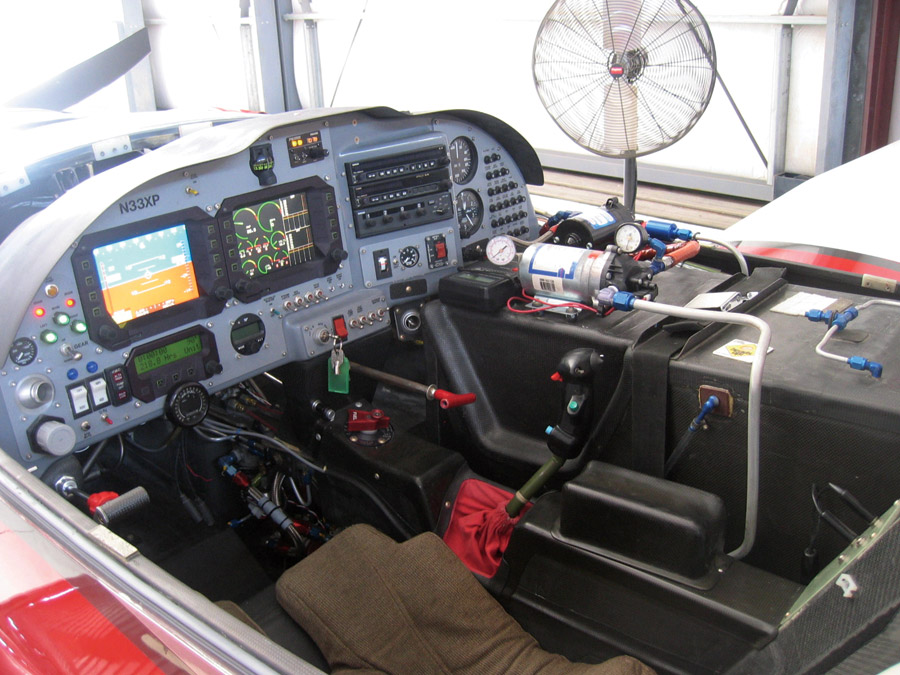
The ADI tank occupies the passenger seat, along with a significant amount of plumbing, pumps, gauges and sensors.
KP: Anything else you want to tell us about the cockpit?
AC: I reversed the canopy from forward- to rear-hinging so that Darryl could get out of the airplane if need be. That was more for testing and fire. If you pull up off the course and the plane is on fire, that is probably the only scenario where you are going to want to get out of the airplane. Any other time you are so close to the ground that getting out of the airplane is not really an option. There was a lot of engineering involved in designing the canopy blow-off system. All my planes have it. I’m not saying it’s necessary, but it’s nice.
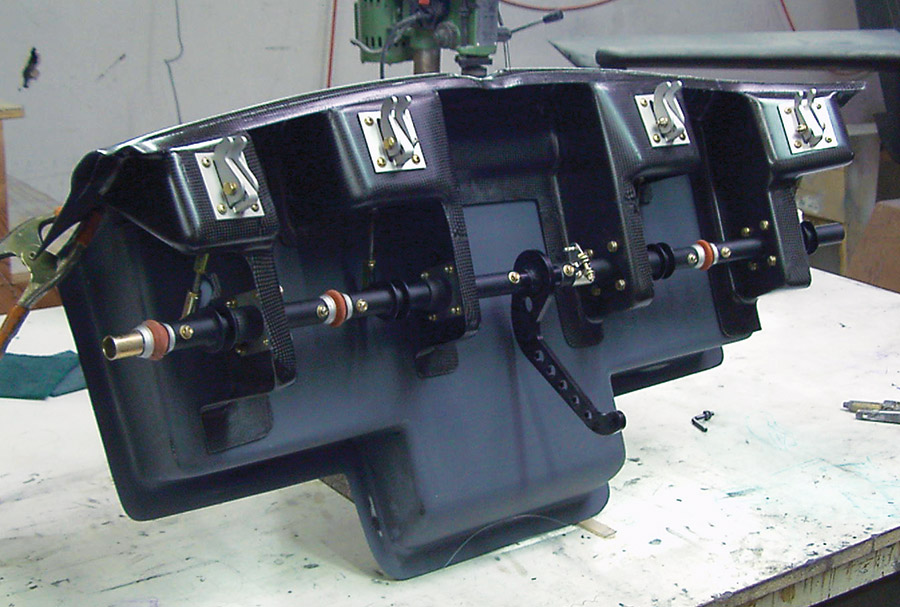
Aerochia’s mechanism for the aft opening canopy hinge is, like all of Chiavetta’s work, a piece of art.
KP: Let’s talk about firewall forward mods. What do you keep from the stock TSIO-550?
AC: Nothing except the bare-bones stock engine and intercoolers. All the external stuff has been changed; we have custom exhaust, custom wastegates, and custom mount. Over the years I also increased the wall thickness of the engine mount tubing as the G-loads went up.
KP: What are the pluses and minuses of intercooling?
AC: Pluses are you can lower the temp of the air going into the engine, i.e., it’s better for preventing detonation. You can do that with ADI, but ADI robs horsepower. If you can lower the air temp as much as possible before introducing ADI, you are better off. Minuses are drag. We have large blisters on the top of the cowl and are venting the intercooler air out the top, too, so that is going to disturb the airflow for sure.
That said, when we compared Darryl’s airplane to a stock Legacy, his ended up being aerodynamically cleaner, even though the cowling doesn’t look as clean. A lot of that is the plenum work: shoving the air into the cowl and using every bit of air with no leakage. Our plenum system is complicated, but that was key to a lot of the speed. Cooling drag can be 20-30% of overall drag on a certified aircraft, so if you can reduce that, that is great.
Something I could probably refine is making the intercoolers smaller because the stock coolers are not very efficient for our purposes. That is something we do differently from from some other racers. Some folks prefer to have individual holes in the cowling to do individual jobs. You can refine it better that way because if you are just concentrating on one system, it is easier to optimize. What we do is have two inlets doing more than two jobs; they are cooling cylinders, intercoolers, oil, and feeding the turbos. So we are trying to do as much as we can with the least number of holes in the cowling, which is cleaner, but is much harder to optimize.
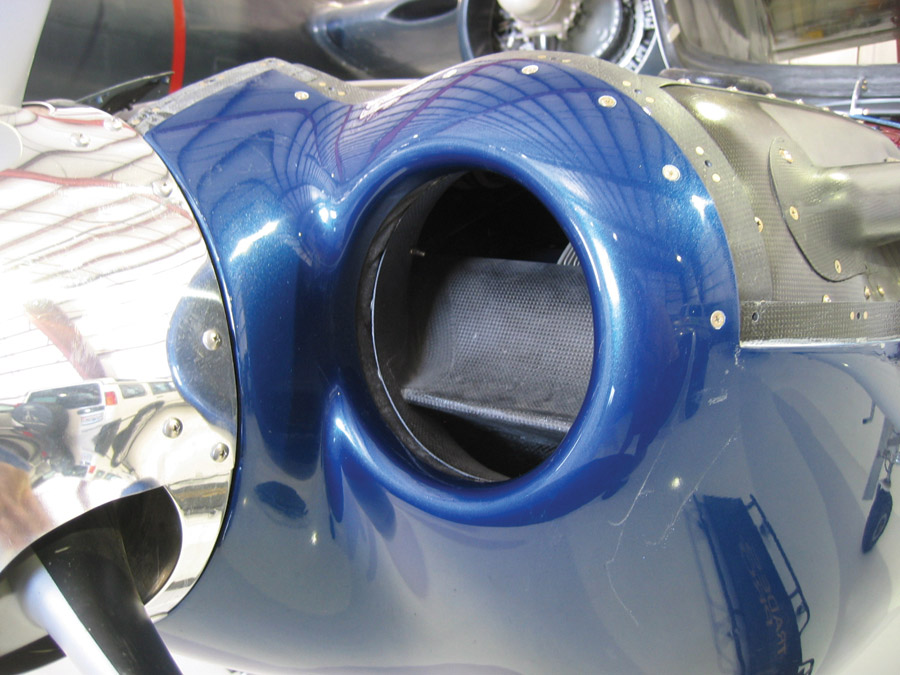
Chiavetta prefers to minimize air intakes, using splitters and diffusers to route the air to its various destinations. Here a splitter forces the majority of air up into the cooling plenum, while the lower portion is routed to the left turbo.
KP: Is inlet air dedicated left and right? For example, some of the Formula 1 racers have individual plenums for each bank of cylinders.
AC: No, the top of the plenum is shared and cools cylinders, oil, and intercooler. I don’t really subscribe to the left/right philosophy. You want the air to have enough space to be able to build up pressure and go through. Having the plenum all the way across communally does that. It also equalizes the pressure. Because of prop rotation, you don’t necessarily have the left inlet seeing the same pressure as the right. But if they are dumping in the same spot, they are going to equalize.
However, the inlets to each turbo are individual, and we always wondered if we should combine the two. We did some tests and found the pressures are so close it wasn’t worth it.
KP: Let’s jump back to why you use Continentals vs Lycomings.
AC: The Continental induction is slightly more advanced; crossflow is better. It also separates induction and exhaust, which is easier for cowling. It’s like Chevy vs. Ford—it really just depends on who you talk to. I prefer Continentals; I’ve been working with them a long time, and I like the setup. And we have found them to be really durable.
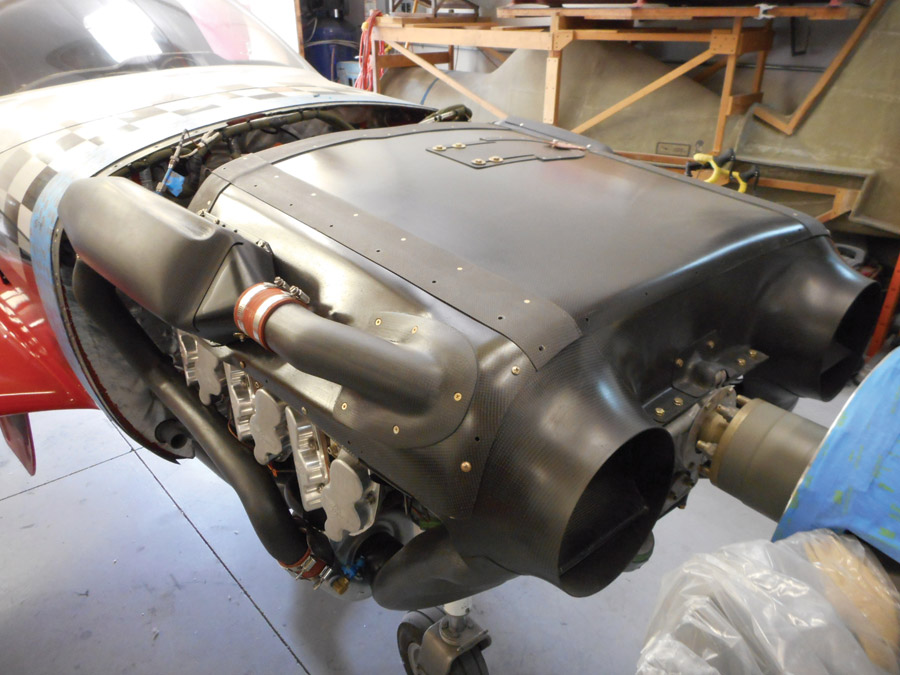
Aerochia’s complex plenum system uses various splitters to duct air to cool the cylinders, intercoolers, oil coolers, and feed the turbos. The Aerochia TSIO-550 kit includes all the necessary parts to modify the engine for racing.
KP: Do the Continental and Lycomings have their own particular failure modes in racing?
AC: We’ve never had a lower end fail on ours. It has always been scorching the top end—that is a mixture/fuel thing. The engine itself has not failed. I don’t know that Lycoming has had full-blown failures either.
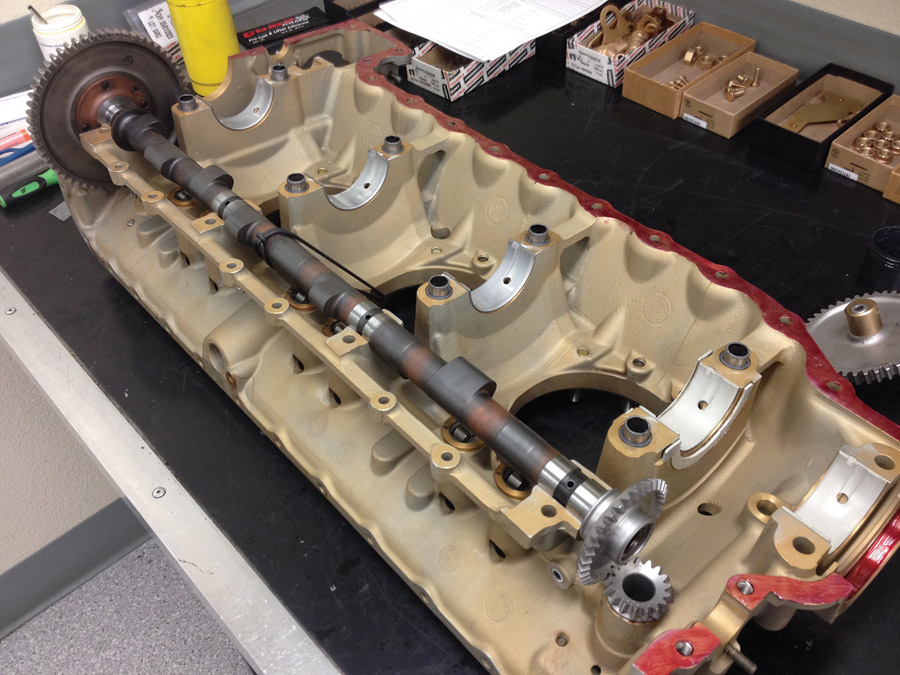
This photo of the race-prepped TSIO-550 bottom shows the dowel pins (either side of the crank bushings), modified cam, and roller lifters.
KP: What are you doing to the internals?
AC: We’ve changed valves, cams, dowel pinned the cases, and use roller lifters and aggressive valve springs. We do all different kinds of things to increase horsepower.
KP: How did you choose a prop?
AC: More rpm is always going to be better for horsepower. But supersonic flow is a limiting factor on prop tip speed. With Darryl’s airplane, we worked with Hartzell. Hartzell designed a very nice prop, and that is one we used for many years. It was able to work in the higher rpm range, i.e., around 3000 rpm, because the tips were really thin. That is not necessarily the most efficient rpm for that prop, but the prop is able to work there.
That was a big thing, choosing a prop. There were times when some independent designers were knocking on our door to do new designs. But prop design is really difficult, and when those things let go, you can lose the plane. So we decided to go with a certified prop company, i.e., Hartzell. They are pretty conservative with their engineering.
One of the things about racing is you try to put the odds in your favor. You could try everything in the book, and what you are going to have is a bunch of stuff that is giving you headaches. Sometimes you want to try this, that, and another thing, but that will get you. Sometimes a conservative route is better. People ask, “Why don’t you use fuel injection and electronic ignition?” Well, it is more components to fail. Mags are fine at the rpms we are running. Yes they’re primitive and there could be improvements, but is it worth the failure rate? Reno is a game of attrition, just being able to do the whole week.
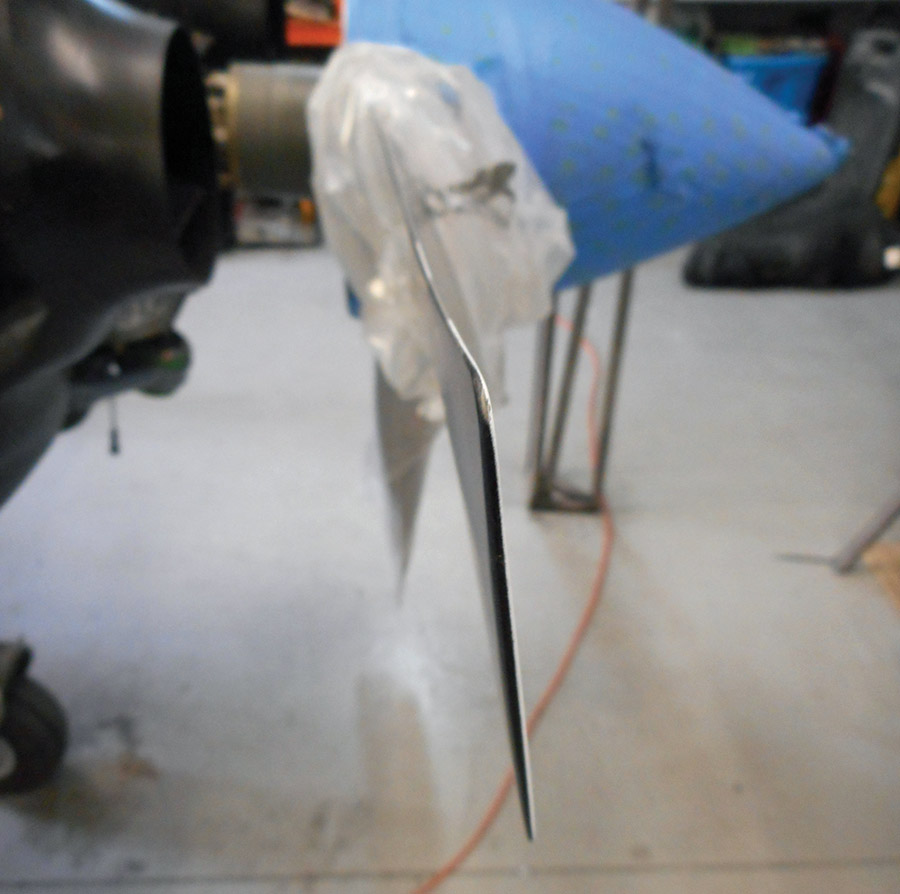
The tips of the Hartzell prop are not much thicker than a nickel, which helps as the prop RPM pushes this area into the transonic range.
KP: It seems like modern EI/FI are relatively reliable though.
AC: Well, you have triggers, a lot of engine sensors, and individual fuel injectors. There are more parts. Any time you put more parts in the system, there are more failure points. You are also putting these things in a hell of an environment: the vibration, the ADI, all that water, and some serious heat. You are throwing electronics into an environment they don’t want to be in. On the other hand, mags are primitive, but as long as they are spinning…I’ve never had a mag fail. We’ve had mags get damaged but still work. We tried EI, and we had several failures. We didn’t really give it enough time to wring it all out, but we don’t have that time. More power to people if they can do it; that is great. But to make it through the week, I’d rather increase my odds with something simple.
KP: If a person wants to get into Gold Class Sport with a Lancair, what kind of horsepower do they need to be making?
AC: To be competitive, 650-750 hp. That is where we think we are. As Darryl said, “There is no substitute for horsepower.” The Legacy may not be the cleanest, but it is a good, solid platform, and we have always gone the route of trying to get more horsepower.
KP: If someone wants to mod out a Lancair for racing, what kind of money are they looking at?
AC: I’d say $350-400,000. It really depends on how much you are willing to do yourself. The NXTs are a lot more than that. The NXT kit—and the labor to build those planes—is a lot. You have to have someone specialized to help build it or have a lot of free time. So racing your friends in an RV with just a few mods, that’s good bang for the buck!
A lot of the Lancairs do have the aerodynamic speed mod kits because it is fairly easy to do while you are building the airplane, and they are cost effective. The full turbo thing is not great for everyday flying. That is another thing you’ve got to decide: If you are going to be in the top Gold, your airplane is no longer a pleasure airplane. It is built for racing. In the beginning we used Darryl’s to go to Sun ‘n Fun and Oshkosh, but over the years it became a purpose-built racer. You had probably better realize that because you don’t want to push an engine that hard, and push an airframe that hard, and then take the family flying.
A corollary to adding mods is that, if it’s not necessary, don’t put it in. It’s a raceplane. A super-duper avionics package, a super-duper autopilot, etc. are not going to help you at Reno. These planes get heavy; that is the nature of turbos, all the ADI systems, all the plumbing, the bodywork, the fairings. The lighter the airplane, the better—not so much for speed, because the speed difference between a heavily loaded airplane and a light airplane is not much—maybe a knot in straight-and-level flight. But as the weight goes up, the induced drag in turns goes up immensely.
KP: How heavy are your raceplanes compared to a stock Lancair?
AC: Honestly, Darryl’s airplane is very close to a stock Lancair because I’ve taken a lot of stuff out, and a lot of guys end up putting too much stuff in. The nature of a lot of the Lancair IVs and Legacys is they have AC, fancy paint jobs, lush interiors, and heavy panels. Some of those planes are very piggy. Our plane is heavy, but not nearly as heavy as some of the stock planes. I feel comfortable knowing that we’ve lightened it up pretty well.
KP: Thanks for sharing 15 years of speed knowledge with us. I’m sure you haven’t quite told us everything! Good luck at Reno this year.
AC: Thanks. Yeah, we still have a few secrets up our sleeve!
This interview was edited for length and clarity. An unedited transcript of the full interview can be found here.


